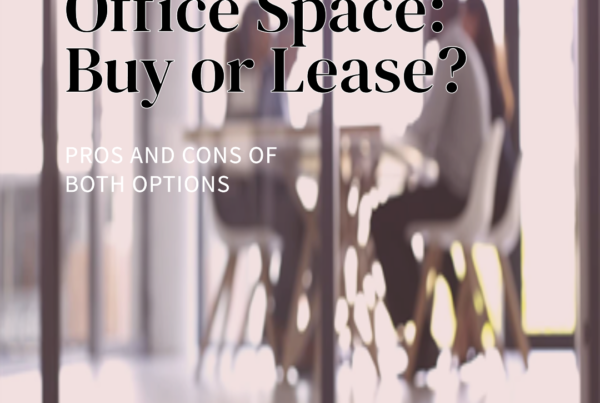
Finding office space for lease can be a frustrating and difficult process and much more difficult than finding a personal property. For those unfamiliar with the process, becoming accustomed to the many added complexities of commercial real estate, in addition to considering the many needs of your business, can be an overwhelming process. This is why it is important to break your work down into manageable steps and work through them bit by bit to get the job done.
Here is a simple step-by-step process to help you find the perfect office space to rent.
Step 1: Set Out Your Initial Criteria
The first step to finding your office space is to set out some initial criteria to help eliminate options that will not suffice in your search. This includes what amount of space your office will need, the total budget for rent, the class of office space you are looking for, and the needs of stakeholders. It is also important to consider leaving room to grow depending on your company’s growth potential. Setting out a list of your company’s initial criteria makes it easy to receive input from stakeholders and begin determining what options are available to you. Here are some tips for setting out your initial criteria.
Image Credit: qimono / Pixabay
Determine What Amount of Office Space Is Required
The exact amount of office space you need will depend on the number of employees your company has as well as the kind of workspace each employee requires. Generally, it should be assumed that every employee will need an absolute minimum of 75 square feet, and upper-level employees will need at least twice that for both work and office space. Of course, this would be an extremely cramped space without any amenities, so if your budget allowed you to go more generous, that would be advisable.
Also, many companies will have additional “musts” beyond working space for each employee, and it is important to have these figured out before beginning your search. A common must is a waiting area for customers, conference spaces for employee meetings, kitchens, mailrooms, and many others. It is important to account for these spaces in your criteria. A good way to do this is to take your estimate of required space based on your number of employees and then multiply this by 130% to account for additional space for other needs. Depending upon your growth potential, you may wish to add on an additional amount to leave room to grow.
Consider Location
Another important criterion to account for is location. Where can your office space be located where it is convenient and accessible for your employees and clients, as well as any required suppliers. Some important factors to consider include the proximity of any options to major roadways, public transportation, and your clientele.
What Class of Office Building Is Right for You?
There are three primary classes of office buildings that generally refer to the quality, amenities, and accessibility of the structure in question. Once you have considered your needs as well as those of your clients, you can determine which of the following classes fits your criteria best.
- Class A: Class A offices are of the highest quality on the market, with roomy interiors, high accessibility, and high-end amenities for tenants. These are the best locations on the market. Generally, these offices are a good choice when they are needed not just for employees but for impressing clients as well.
- Class B: Class B offices are the choice for a wide band of companies in need of average office space. Generally, these are respectable and functional spaces, but without the frills such as striking architecture, valet service, gyms, and daycare of a Class A structure. These offices may not be quite as accessible as Class A structures or have quite the same flashy appearance, but they do offer a functional and comfortable workspace, and they are the class of choice for many companies.
- Class C: Class C offices are the lowest quality on the market and are most often offered as fixer-uppers to investors that would like to repair them up to a Class B structure. However, some businesses on a budget that need a functional place to work may choose these office spaces. The most common tenants of Class C properties include small businesses that perform service or industrial activities.
How Soon Do You Need to Move In?
Whether you are just getting started or you are an established company, it is important to avoid interruptions in your business activity. This means that if you need to be moved into your new space within a certain time frame, this could narrow your field of options considerably. You may also need to account on time for build-out, which may vary in length considerably based on your office’s needs. Once you have determined any time constraints, you can search for commercial space for rent that can be leased within these periods. You may also wish to consider leasing terms as well. Most commercial leases range between three to five years, and some may have a minimum leasing period.
Step 2: Determine Your Budget
Office space is often one of the highest operating costs for a business, and it is important to be certain that your company can afford any new space. The cost of commercial property for rent can vary wildly based on location, so to find a realistic estimate for the budget your business will require for office space, try basing it on the average rental costs in your area.
To do this, perform a quick search for the average cost of office space per square foot in your local area, preferably based on the class of office you would like as well, and multiply it by the estimate of space your office will require you found earlier.
Next, add on an estimate of common area maintenance fees, which are what you will pay to maintain common areas such as elevators and the lobby, which are generally determined based on square footage. With a bit of research, you will likely be able to find the typical fees for office spaces in your local area, but generally, these will be from 5% to 15% of the overall lease amount.
Finally, account on an average for utilities to your estimated budget amount. On average, utilities account for approximately $2.15 per square foot but will vary a bit in practice based on location. So, multiply an estimated average based on your location by your ideal office size and add this to your estimate to find your total estimated budget.
Step 3: Find Office Space That Fits Your Criteria & Budget
Now that you have your criteria and budget set out and ready, it is time to find an office space that meets them. To do this, you can begin to do a little legwork on your own and perform a web search for properties in your area. Now you can use websites such as Atrium Properties for properties near Clifton Park (NY) to search for suitable office space for rent. This will give you the opportunity to identify suitable office rentals and make a list of options to investigate further. From here, you can decide which properties are worth touring.
Evaluate & Tour Suitable Properties
Now that you have some offices for rent set out that meet your criteria, it is time to narrow your options down to one. So, gather the contact information for your chosen office rentals’ listing agents and schedule a tour. As you get ready for your tour, make sure to come equipped with all of the information you have available on the property. Try researching facts such as the age of the building and its utilities as well as any security features to prepare yourself to ask any questions you may have. On the tour itself, here are a few details to pay particular attention to.
The Neighborhood
Outside of the building itself, one of the most important factors for many businesses in choosing between offices for lease is the appearance of the neighborhood. When clients visit your office, what would you like them to see? For some industrial companies, this may not be of much importance, but for others, it may be a deciding factor. A particularly important detail for some may be the accessibility of the commercial property for rent. Are there sidewalks and other conditions that will make it easy for pedestrians to access your office?
Amenities
Many office spaces offer in-house amenities that can be of great value to tenants, such as gyms, daycares, and cafes. In some cases, these may be an important factor in choosing a space that benefits your employees. So, if any of these amenities are a must, ask the leasing agent what services are available and determine if these services are available and what they might cost.
Ease of Access
A vital factor in deciding on any office space is the ease with which you, your clients, and your employees will have in accessing it. If your work and employees center around a given community, make sure that it is easy for you to commute between them. Also, consider the availability assuming that the space does not come with its own parking lot. Consider what the situation with parking for your employees and clients will be. In some cases, a lack of parking can place a hardship on your employees and limit clients’ ability to access your office.
Step 4: Prepare Your Documents & Finances
Once you have selected some office spaces, you would like to make an offer. It is time to get ready. You will need a variety of documentation to show that you are a legitimate business and will be able to pay rent reliably. Also, you will want to take a look at your business’s finances and get an idea of how creditworthy your business is. Potential landlords will be taking a close look at your finances, and you will need to be ready to negotiate. Some steps to take to prepare to include:
- Gathering Financial Documents: In order to show your potential landlord that you will be a stable tenant able to pay rent, you will need to present certain financial documentation. Common documents you will need include credit reports, profit and loss statements, tax returns, bank records, and balance sheets. If possible, it is best to obtain these for the past three years, but this may not be possible in all cases. Notably, landlords will often take your own credit report into consideration, so in order to prepare, try getting a credit report that performs a soft inquiry, which won’t hurt your credit, on both you and your business to show to landlords.
- Contact References: Landlords will often request references from previous landlords in order to make an informed decision about renting to your business. So, before you begin making any offers, try getting letters of reference from any previous landlords you may have had.
- Prepare to Sign a Personal Guarantee: In order to acquire office space, particularly for small businesses and startups, a potential landlord may require a personal guarantee. This legal agreement essentially states that you personally give a guarantee that you will cover the rent should your business be incapable of doing so.
Step 5: Negotiate a Lease
After you have settled on an office space that meets all of your needs and finances, it is time to work on negotiating a lease and work on getting the best deal possible for you and your business. Commercial leases are a very different process from the personal rental agreements you may be used to, and everyone is unique. It is a good idea at this stage to contact legal counsel to help create an agreement that represents your interests as well as those of your potential landlord. However, there are a few things you should know about commercial leasing agreements starting with the three types of leases. These include:
- Gross Lease: With this type of lease, which is also known as a full-service lease, the tenant will pay a fixed payment each month, and the landlord will cover all of the expenses related to the property, such as utilities, maintenance, taxes, and insurance.
- Modified Gross Lease: A modified gross lease means that instead of paying one monthly payment that covers all expenses related to the property, the tenant will be responsible for some costs. These may be paid directly by the tenant, or the landlord may bill the tenant for these costs.
- Net Lease: A net lease means that the tenant will pay a monthly base rent, but then the tenant will also be responsible for paying additional monthly fees, the exact amount of which will be determined in the leasing agreement. With this type of lease, tenants will also be responsible for utilities.
In addition to understanding the type of lease you are negotiating, it is important to consider the total rent you will be paying both now and in the future. This means determining if there are any rent escalation clauses in your agreement. These are quite common, but you should be aware of the amount that the rent will increase and make sure that the total increase will leave the rent within your budget. Also, remember to determine who will be responsible for the costs and arrange for any necessary build-outs to make the space ready for your company. Finally, consider the length of your lease term and ensure that your lease will not require you to stay for any longer than you are willing to remain.
Final Thoughts
Renting office space can be a difficult task, but by following these five steps, you can break it down into a manageable process that will help guarantee you find the place you have been looking for. Just remain patient and follow through step by step, and you will be in your new office before you know it.
Image credit: reallywellmadedesks / Pixabay





